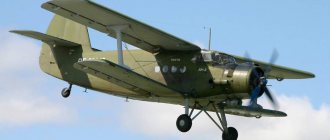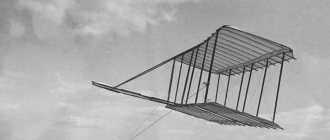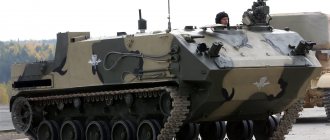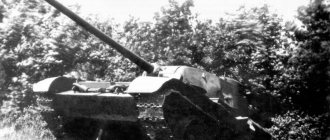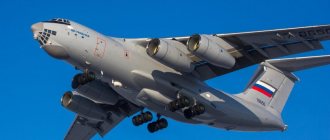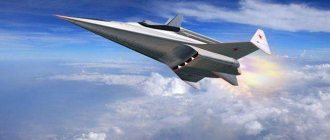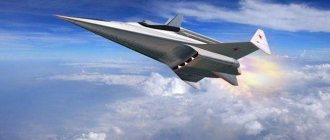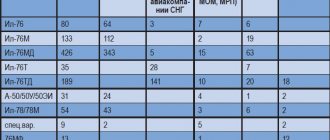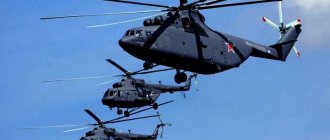At the very height of the war, in 1943, the S. Ilyushin Design Bureau began designing a medium-haul passenger airliner.
It took less than a year to approve the layout design of the future IL-12. In 1945, the machine was already built and in the spring of 1946 the debut flight was carried out.
The aircraft became absolutely in demand, widespread, and the number of copies over the three years of production (1946 – 1949) reached 663.
A few months after the first flight, serial production of Il-12 aircraft began. The aircraft operating on domestic flights have shown how easy they are to operate, reliable, and error-free in the air.
In 1948, the idea of an international flight came true. The first regular commercial flight took place to Bulgaria. Now the proven Il-12 successfully operated flights to foreign destinations in Eastern European countries, Afghanistan, and Iran.
It was necessary to maximize the full potential of the aircraft, so another opportunity to test this was a long flight from Moscow to the Far East. The plane flew to Khabarovsk for 28 hours, with five refueling stops.
The characteristics of the aircraft turned out to be quite suitable for flights in permafrost conditions. For many years, Il-12 vehicles were used in the extreme Northern and Southern latitudes.
Despite the numerous production and continuous operation of this model, the beginning of the fifties was the era of its decline. The OKB has already presented an improved IL-14 airliner with more powerful parameters. 1968 marks the end of the Il-12 aircraft's operation in the airspace.
Technical Specifications Overview
The aerodynamic design is normal: an all-metal low-wing aircraft with a single fin. The chassis is classic, three-wheel (for that time this was a novelty).
The power plant is represented by ASh-82FN piston engines. Feather propellers installed.
The aircraft is a mid-range passenger airliner. Designed to accommodate up to 32 people, plus a crew of 5 people and luggage.
For thermal insulation of the cabin, laid wool batting was used, on top of which was finished with aircraft fabric. Fuel with a volume of 6000 liters was contained in 10 tanks.
In addition, the aircraft had a hydraulic system, anti-icing, heating and ventilation systems.
Radio equipment, electrical equipment and a fire-fighting complex are located on board.
Notes
- ↑
[www.ilyushin.org/history/dates.html Official website of JSC Aviation Complex named after. S.V. Ilyushin." Dates of first flights.] - ↑ 1 2 3 Talikov N.D.
Three quarters of a century of “Ilyushin’s” sky... - M.: Bulletin of the Air Fleet, 2008. - P. 116 - ↑ 1 2 Udalov K. G., Maraev R. V.
Ilyushin’s first-born passenger // Aviation and time. - 2000. - No. 5. - P. 16 - ↑ Talikov N.D.
Three quarters of a century of “Ilyushin’s” sky... - M.: Bulletin of the Air Fleet, 2008. - P. 97 - ↑ Talikov N.D.
Three quarters of a century of “Ilyushin’s” sky... - M.: Bulletin of the Air Fleet, 2008. - P. 98 - ↑ 1 2 Talikov N.D.
Three quarters of a century of “Ilyushin’s” sky... - M.: Bulletin of the Air Fleet, 2008. - P. 115 - ↑
Ed. board: Kutepov A. Ya., Makarevsky A. I., Minaev A. V., Novozhilov G. V. and others. Scientist and designer S. V. Ilyushin. - M.: Nauka, 1978. - P. 79 - ↑ Egorov Yu. A.
Aircraft from S. V. Ilyushin Design Bureau. - M.: RUSAVIA, 2003. - P. 217 - ↑ Talikov N.D.
Three quarters of a century of “Ilyushin’s” sky... - M.: Bulletin of the Air Fleet, 2008. - P. 120 - ↑ Talikov N.D.
Three quarters of a century of “Ilyushin’s” sky... - M.: Bulletin of the Air Fleet, 2008. - P. 117 - ↑
[www.airforce-magazine.com/MagazineArchive/Documents/KittyHawkChronology/kitty1947-53.pdf The Search Engine that Does at InfoWeb.net] - ↑
[www.rg.ru/2015/11/26/rodina-rastrel.html?ref=rt.com Execution over Hua Gou], 11.25.2015 Natalya Sergeeva. Internet portal "Rossiyskaya Gazeta - Russian Weapons" - [maximf.ucoz.ru/news/obzor_il_12_ot_amodel/2011-05-14-167 Review of the IL-12 model from Amodel]
Flight capabilities and parameters
- Aircraft length – 21.31 meters
- Machine height – 7.8 meters
- Wingspan – 31.7 meters
- Flight altitude, ceiling – 6700 meters
- Motors - ASh-82FN (2 piston engines)
- Power, traction – each 1850 horsepower
- Propeller – four-blade AB-9E
- Screw diameter – 4.1 meters
- Takeoff weight – 11280 kilograms
- Flight range – 1500 kilometers (fully loaded)
- Cruising/maximum speed – 325/445 km/h
- Passenger capacity – from 27 to 32 people
- Crew – 4 people
Production
Serial release[13]:
Plant No. 84 (Tashkent)
- Il-14: 1954 - 28 aircraft, 1955 - 52 aircraft, 1956 - 115 aircraft;
- Il-14P: 1957 - 117 aircraft, 1958 - 1 aircraft;
- Il-14T: 1956 - 10 aircraft, 1957 - 26 aircraft, 1958 - 29 aircraft.
Plant No. 30 (Moscow)
- Il-14P: 1956 - 249 aircraft, 1957 - 114 aircraft, 1958 - 2 aircraft.;
- Il-14T: 1956 - 23 aircraft, 1957 - 205 aircraft, 1958 - 63 aircraft;
- Il-14FC: 1957 - 25 aircraft, 1958 - 6 aircraft.
Avia plant (Czechoslovakia)
- In total - 203 aircraft.
Dresden Aircraft Factory (GDR)
- In total - 80 aircraft.
The total number of IL-14s produced: 1348 aircraft (USSR - 1065, Czechoslovakia - 203, East Germany - 80), of which at least 500 units were exported[14].
According to other sources, all of them were produced in the USSR in 1952-58. over 3500 copies of all models.
Modification series
Over the three years of production of the IL-12, four types of modifications of this machine became known. In the mid-fifties, fifty units underwent the modernization procedure to the level of Il-14.
No more than fifteen copies were intended for transporting high-ranking officials; they had lying seats, leather sofas, and bars. IL-12 is also a flying laboratory for conducting various types of tests and verifications. These aircraft are indispensable for geological and other surveys and observations.
- IL-12 is the base model of the series. 27 passengers could be accommodated, but other layout variations were also carried out.
- The Il-12B aircraft was one of the improved versions of the Il-14. There was a new anti-icing system.
- Il-12D – transport model (carried 3.7 tons of cargo). It was also used to land 38 people.
- Il-12T is a cargo version of the base vehicle. It was widely and successfully used for a long time in the polar latitudes for the delivery of mail, provisions, people and equipment. This cargo aircraft, with a large double door and winches for loading rigging, had good lifting capacity and was adapted to poorly equipped runways.
Monuments
Il-14 in Balashov
Il-14 in Begoml, Belarus
Il-14 in Sinsheim, Germany
In the Main Branch Museum of the History of Civil Aviation. City of Ulyanovsk. No. USSR-06132.
- The polar aviation aircraft Il-14P is on display at the Kiev State Aviation Museum.
- The Kurgan Aviation Museum displays the Il-14T transport aircraft.
- In the center of the village of Brinkovskaya, Krasnodar Territory.
- In the cities of Begoml and Svetlogorsk, Republic of Belarus. (Dismantled in Svetlogorsk, 04/29/2011 after restoration installed in the Aircraft Museum, Borovaya, Minsk)
- At Talagi airport (Arkhangelsk).
- At the Air Museum Sinsheim, Germany.
- On the territory of the Museum of the Vietnamese People's Army in Hanoi (decommissioned Il-14T tail number VN-C516 aircraft).
- In the city of Balashov, Saratov region, on the territory of OJSC "Rembaza" and on the territory of BVVAUL.
- At the airport in Ulaanbaatar Mongolia 47°50′38″ N. w. 106°46′05″ E. d. (G) (O)
- In the city of Kuibyshev, Novosibirsk region.
- In the village of Cape Shmidt (urban-type settlement), Chukotka Autonomous Okrug.
- At the airport of Burgas (Sarafovo), Bulgaria
- At the airfield in the village of Froly, near Perm, board USSR-29112.
Il-14 at Talagi airport ()
What are the advantages of the IL-12 and are there any disadvantages?
The fact that the airliner quickly and for a long time conquered domestic passenger routes and performed many flights abroad is an undoubted indicator of its merits.
The Ilyushin “firstborn” of civil aviation was easy to operate; there was almost no need to train pilots for it. Reliable and safe - the number of accidents involving the IL-12 was minimal. The aircraft was used in the Soviet Union until the end of the sixties, and in China the last copy was taken out of circulation only in the early nineties.
There were also shortcomings in the design of the model. There was an inability to continue the flight and make a safe landing if one of the engines failed. It was necessary to refine the landing gear mechanism and aerodynamic miscalculations.
History of creation
The development of the Il-12 aircraft began, no matter how strange it may seem, in 1943. Passenger cars were not an urgent need back then; the Li-2 (and export S-47) suited everyone. And the design bureau itself was not idle, developing, for example, new Il-10 attack aircraft. And yet, Sergei Ilyushin decided at the height of the war to start developing a promising airliner. Moreover, not by remaking it, say, from the Il-4 bomber, but by starting from scratch.
It was decided to take the notorious DC-3 as a guide - the future IL-12 even had a significant external resemblance to it. But there were also important differences. The planned vehicle was planned to be equipped with 4 high-altitude M-88V engines, the superchargers of which would ensure sealing of the interior. And they were going to abandon the traditional landing gear with a tail wheel in favor of a more modern design with a nose strut. The project was met with approval in the Kremlin.
January 1944 brought significant changes. The 4-engine design and M-88V engines were abandoned in favor of 2 ACh-31 diesel engines. This promised to improve the aircraft's aerodynamics, especially at cruising speeds. However, the sealed interior had to be abandoned - all the air pumped by the compressors was consumed by the engines. In the spring of the same year, the diesel IL-12 project was approved, and by the fall a full-size mockup was ready.
Assembly of the prototype was completed after the victory over the Reich - in the summer of 1945.
In August, Vladimir Kokkinaki, together with his brother Konstantin, took the Il-12 into the air.
Immediately after the start of factory tests, it became clear that there was a mistake with the engines. The ACh-31 diesel engines turned out to be “crude”, unreliable, and jeopardized the timely delivery of the aircraft.
As a result, they decided to replace them with one of the most famous and widespread wartime aircraft engines - ASh-82FN. Testing of the modified prototype began in 1946. And in the summer of the same year, the aircraft was sent for state tests. In October, the Ministry of Aviation Industry issued an order to launch the Il-12 into series.
Rich biography
The post-war airliner for peaceful use was only the beginning of a long and glorious journey for the Ilyushin Design Bureau.
Multiple parameters were worked out and tested on the first civilian model. During operation, in the event of emergency situations and accidents, defects were eliminated, materials and systems were changed and improved. More advanced passenger and military aircraft became followers of the Il-12.
According to the classification of NATO designations, the IL-12, due to its omnipresence and irreplaceability, received the name “intercity bus”.
The biography of the small aircraft is very rich and is historical for the development of the world civil aircraft industry.
Links[edit]
| Wikimedia Commons has media related to IL-12 . |
Notes[edit]
- "Ilyushin Il-12". Planepictures.net
. Retrieved May 4, 2013. - ^ ab “Dates of the first flights of Ilyushin Design Bureau aircraft.” Archived on July 18, 2011 at the
Ilyushin
Backward Machine aviation complex . Access date: November 13, 2010. - ^ a b c d Gunston 1995, p. 110.
- ↑
Gordon, Komissarov and Komissarov 2004, pp. 160–161. - Accident Description for CCCP-L1317 in the Aviation Safety Network. Retrieved January 20, 2016.
- Aviation Safety Network Crash Description for CCCP-N439. Retrieved November 10, 2016.
- Accident Description for CCCP-L1343 in the Aviation Safety Network. Retrieved January 20, 2016.
- Description of the CCCP-L1465 accident in the aviation safety network. Retrieved January 20, 2016.
- Accident Description for CCCP-L1427 in the Aviation Safety Network. Retrieved January 20, 2016.
- Description of the CCCP-L1450 accident in the aviation safety network. Retrieved January 22, 2016.
- Aviation Safety Network Crash Description for CCCP-L1731. Retrieved January 20, 2016.
- Description of the CCCP-L861 accident in the Aviation Safety Network. Retrieved January 20, 2016.
- Aviation Safety Network Crash Description for CCCP-L1381. Retrieved January 22, 2016.
- Aviation Safety Network Crash Description for CCCP-L1791. Retrieved January 22, 2016.
- Aviation Safety Network Crash Description for CCCP-L1714. Retrieved January 22, 2016.
- Aviation Safety Network Crash Description for CCCP-L1434. Retrieved November 10, 2016.
- Accident Description for CCCP-L1844 in the Aviation Safety Network. Retrieved January 22, 2016.
- Aviation Safety Network Crash Description for CCCP-L1462. Retrieved January 22, 2016.
- Description of the CCCP-L1340 accident in the aviation safety network. Retrieved January 22, 2016.
- Aviation Safety Network Crash Description for CCCP-L1803. Retrieved January 22, 2016.
- Crash Description for CCCP-L1706 in the Aviation Security Network. Retrieved January 22, 2016.
- Aviation Safety Network Crash Description for CCCP-L1811. Retrieved January 22, 2016.
- Accident Description for CCCP-L1313 in the Aviation Safety Network. Retrieved November 10, 2016.
- Aviation Safety Network Crash Description for CCCP-L1775. Retrieved January 22, 2016.
- Aviation Safety Network Crash Description for CCCP-L1849. Retrieved November 10, 2016.
- Aviation Safety Network Crash Description for CCCP-L1308. Retrieved November 10, 2016.
- Accident Description for CCCP-L1312 in the Aviation Safety Network. Retrieved November 10, 2016.
- Description of the accident for SP-LHC in the aviation safety network. Retrieved January 22, 2016.
- Aviation Security Network Crash Description for CCCP-L1488. Retrieved November 10, 2016.
- Aviation Safety Network Crash Description for CCCP-L1328. Retrieved January 22, 2016.
- Accident Description for CCCP-L1435 in the Aviation Safety Network. Retrieved January 22, 2016.
- Aviation Safety Network Crash Description for CCCP-L1777. Retrieved November 10, 2016.
- Aviation Security Network Crash Description for CCCP-L1375. Retrieved January 22, 2016.
- "Up From Kitty Hawk 1947-1953". airforce-magazine.com.
Access date: July 17, 2011. - Description of an accident in the aviation safety network. Retrieved January 22, 2016.
- Accident Description for CCCP-L1727 in the Aviation Safety Network. Retrieved November 10, 2016.
- Aviation Safety Network Crash Description for CCCP-L1765. Retrieved January 22, 2016.
- Aviation Safety Network Crash Description for CCCP-L1367. Retrieved January 22, 2016.
- Aviation Safety Network Crash Description for CCCP-L1365. Retrieved January 22, 2016.
- Aviation Safety Network Crash Description for CCCP-L1789. Retrieved January 22, 2016.
- Description of the CCCP-L1320 accident in the aviation safety network. Retrieved January 22, 2016.
- Aviation Safety Network Crash Description for CCCP-N479. Retrieved January 22, 2016.
- Accident Description for CCCP-L1359 in the Aviation Safety Network. Retrieved January 22, 2016.
- Description of an accident in the aviation safety network. Retrieved January 22, 2016.
- Description of the CCCP-N525 accident in the aviation safety network. Retrieved January 22, 2016.
- Description of the accident for OK-DBP in the aviation safety network. Retrieved January 22, 2016.
- Aviation Safety Network Crash Description for CCCP-L1828. Retrieved January 22, 2016.
- Aviation Safety Network Crash Description for CCCP-L1389. Retrieved January 22, 2016.
- Aviation Security Network Crash Description for CCCP-N442. Retrieved January 22, 2016.
- Aviation Safety Network Crash Description for CCCP-L1309. Retrieved January 22, 2016.
- Aviation Security Network Crash Description for CCCP-L1364. Retrieved January 22, 2016.
- Crash Description for CCCP-L3904 in the Aviation Security Network. Retrieved January 22, 2016.
- Aviation Safety Network Crash Description for CCCP-04249. Retrieved January 22, 2016.
- Aviation Safety Network Crash Description for CCCP-01426. Retrieved January 22, 2016.
- Aviation Safety Network Crash Description for CCCP-01405. Retrieved January 25, 2016.
- Jońca, Adam (1985). Samoloty linii lotniczych 1945-1956
, WKiŁ, Warsaw, ISBN 83-206-0529-6 (in Polish), p.15 - Stroud 1968, p. 99.
- Stroud 1968, p. 100.
- Stroud 1968, p. 110.
Literature
- Egorov Yu. A.
Aircraft from the S. V. Ilyushin Design Bureau. - M.: RUSAVIA, 2003. - 336 p. - pp. 208-217, 298-300. — ISBN 5-900078-20-5 - From the history of Soviet aviation: Aircraft of the S.V. Ilyushin Design Bureau / G.V. Novozhilov, D.V. Leshchiner, V.M. Sheinin, etc.;
Ed. Novozhilova G.V. - M.: Mashinostroenie, 1990. - P. 175-201. — ISBN 5-217-01056-8 - Ponomarev A. N.
Designer S. V. Ilyushin. - M.: Voenizdat, 1988. - P. 349-359 - Soiko N.
Ready for labor and defense // Model designer. — 2005. — No. 3. — P. 26-31 - Talikov N.D.
Three quarters of a century of “Ilyushin’s” sky... - M.: Bulletin of the Air Fleet, 2008. - 464 p. — ISBN 5-901808-13-4 - Udalov K. G., Maraev R. V.
Ilyushin’s first-born passenger // Aviation and time. — 2000. — No. 5. — P. 4-17 - Shavrov, V. B.
History of aircraft designs in the USSR 1938-1950. - M.: Mechanical Engineering, 1988. - 568 p. — 20,000 copies. — ISBN 5-217-00477-0. - Yakubovich N.V.
Airplanes of Ilyushin. The best of the best. - M.: Yauza: Eksmo, 2009. - 480 p. - pp. 247-269. — ISBN 978-5-699-33921-1
| Aircraft of the Ilyushin Design Bureau | |
| Bombers |
|
| Stormtroopers |
|
| Torpedo bombers and anti-submarine aircraft |
|
| Transport aircraft or dual purpose |
|
| Special aircraft based on transport |
|
| Passenger aircraft |
|
| Special aircraft based on passenger |
|
| Current projects |
|
| Unrealized/experimental |
|
| Notes: italics indicate promising, experimental, or samples that did not go into mass production; bold indicates serial samples; ¹ together with Beriev Design Bureau; ² together with NPK Irkut |
| Aeroflot aircraft | |
| 1920-1930s |
|
| 1940-1950s |
|
| 1960-1970s |
|
| 1980-1990s |
|
| 2000-2010s |
|
| * – aircraft currently withdrawn from passenger service. |
This page was last edited on January 1, 2019 at 12:06 pm.
Exploitation
At the beginning of 1947, five Il-12 aircraft of the experimental series were transferred for operational testing to the first separate air group of the Civil Air Fleet, which was based at Vnukovo airport. During operational testing, 1,500 flights were performed. According to the pilots, the Il-12 was easy to control and could be piloted by both I and II class pilots[7]. Operational tests were completed on May 20.
On May 1, 1947, a group of Il-12s took part in an air parade over Red Square.
On June 1, 1947, regular passenger operation of the Il-12 began at Aeroflot[2].
In 1948, the Il-12 was launched on international scheduled flights. The first airline to use the Il-12 was Moscow - Sofia. Then Il-12s began to fly regularly to Berlin, Belgrade, Budapest, Bucharest, Warsaw, Vienna, Kabul, Prague, Tehran, Stockholm, Helsinki, and Ulaanbaatar. In 1954, the Moscow-Paris airline opened.
In the USSR, the longest flight of the Il-12 was Moscow - Khabarovsk, with a length of 7000 km. The flight took 28 hours, with five intermediate landings.
Since 1956, Il-12 aircraft began to be used in Antarctica.
From the second half of the 1950s, the new Il-14 gradually began to replace the Il-12. In the USSR, Il-12 aircraft were operated until 1968, when the crew of Major V.M. Bazilevich transported the last Il-12 from the 478th training aviation regiment in Borisoglebsk to the Cheboksary school of junior aviation specialists[2].
In China, IL-12s were used on passenger lines until 1988[8]. And two military vehicles with tail numbers “35240” and “35241” were used until October 1993, when they were installed in eternal parking at the Datan Shan Museum.
